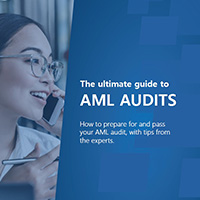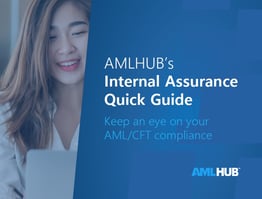AML Acronyms Explained
Learn what these common AML acronyms mean and why they're important
18 common AML acronyms and what they mean
Every industry has its jargon and AML is no different. We've gathered together the most common AML acronyms to help you understand what they mean and why they're important to AML/CFT.

Want a copy of these AML acronyms to keep on file? Download the PDF below.
Anti-Money Laundering (AML) refers to part of the AML/CFT Act 2009, and corresponding AML/CFT obligations that businesses and individuals have under the Act, which are in place to detect and deter money laundering.
Anti-Money Laundering (AML) is the process of detecting and deterring the laundering of money.
The Australian Transaction Reports and Analysis Centre (AUSTRAC) is responsible for overseeing the AML/CFT laws in Australia. As the regulator for over 14,000 entities in Australia, AUSTRAC collects financial information and enforces AML/CFT obligations to detect and deter money laundering and the financing of terrorism.
Before doing business with a customer you need to undertake Customer Due Diligence (CDD). This involves identifying and verifying your clients, any beneficial owners of your client (for example, if the client is a company or trust), and/or anyone acting on behalf of your client (i.e., the person instructing you). You also need to assess and record the nature and purpose of the business relationship with the client and the level of ML/FT risks they pose to your business.
Know Your Customer (KYC) is sometimes used interchangeably with CDD. In New Zealand, the common term is CDD.
Countering the Financing of Terrorism (CFT) is part of the AML/CFT Act 2009, and outlines the policies, procedures, and controls businesses must have in place to prevent their products and services being used to finance terrorism.
Terrorists need funds to operate and often use businesses to wash their cash to make it appear like it comes from legitimate sources. This is why CFT is incorporated into the AML/CFT regime, as the methods for detecting and deterring terrorism financing are the same as those for preventing money laundering.
The Department of Internal Affairs (DIA) is a government agency in New Zealand that is one of the three Supervisors of AML/CFT in New Zealand. It oversees sectors such as casinos, money remitters, FX dealers, real estate, law, and accounting.
As part of CDD, you must determine the level of risk of your client. This is a risk-based approach based on the risk assessment.
When your client is a trust, a foreign PEP, or high risk, you need to complete Enhanced Due Diligence (EDD). To complete EDD you need to take an additional step and obtain Source of Wealth / Source of Funds.
You must obtain and verify information relating to the SOF / SOW of your customer. The circumstances in which you need to do this are detailed within the Act and EDD guidelines. You must take reasonable steps to do this according to the level of risk involved.
Electronic identity verification (eIV) is a way to prove and verify the identity of customers through electronic means, for example, AMLHUB’s AVID system, or RealMe integration.
The Financial Action Task Force (FATF) is an international body with over 200 member countries.
It is responsible for establishing the international standards set for money laundering and the financing of terrorism. Its role includes developing policies to combat money laundering conducted through regulatory, legal, and operational systems. The FATF sets forward recommendations, mutual evaluations, and maintain the blacklist / greylist.
The Financial Intelligence Unit (FIU) is a group under the New Zealand Police that assists with the detection and investigation of money laundering and the financing of terrorism. The FIU collects and analyses information from Reporting Entities through the Suspicious Activity Reports (SARs) they submit as part of their AML/CFT obligations.
The Financial Markets Authority (FMA) is a government agency in New Zealand that is responsible for financial regulation. It is also one of the three Supervisors of the AML/CFT regime, overseeing sectors such as stock brokers, finance companies, derivatives issuers, peer-to-peer lending providers, and financial advice providers.
GoAML is the online portal through which the FIU collects information from Reporting Entities for analysis. This includes Suspicious Activity Reports / Suspicious Transaction Reports, Large Cash Transaction reports, and International Fund Transfer reports. To access this portal you must register your Reporting Entity.
Large Cash Transactions (LCT) are transactions that meet or exceed the NZ$10,000 threshold. LCTs are typically a domestic, physical cash transaction that involves physical currency.
A politically exposed person (PEP) is someone identified as having political exposure in offshore jurisdictions. Companies run their clients through a “PEP Check” and when the person is identified as a PEP, they need to undergo EDD.
A Prescribed Transaction Report (PRT) is a report that must be submitted to the FIU when a Reporting Entity’s customer makes transactions over a threshold of $10,000 or more in physical currency, or $1000 or more if an international wire transfer.
The Reserve Bank of NZ (RBNZ) is the central bank of New Zealand. It is responsible for the operation of monetary policy and currency. RBNZ is also one of the three Supervisors of AML/CFT in New Zealand. It supervises banks, life insurers, and credit unions.
While not an acronym, a Reporting Entity is a business that is captured under the AML/CFT Act, and is obligated to meet the requirements of the AML/CFT Act and regulations. The Supervisors have the obligation of ensuring the Reporting Entities are complying and will take enforcement action when required.
A Suspicious Activity / Transaction Report (SAR / STR) is a report that Reporting Entities submit to the FIU which details activities or transactions by a customer that are considered suspicious.
Your customer's Source of Wealth (SoW) is the origin of their entire body of assets. This information gives an indication of the amount of wealth your customer would be expected to have and a picture of how they acquired it.
Your customer's Source of Funds (SoF) is more narrowly focused. It is the origin of the funds used for the transactions or activities that occur within the business relationship with you.





